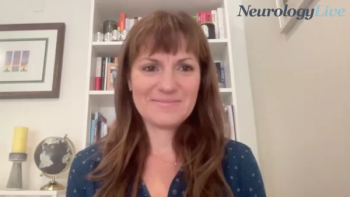
NeuroVoices: George Grossberg, MD, on Properly Using Telehealth to Address Neuropsychiatric Symptoms of Degenerative Diseases
The Samuel W. Fordyce professor and director of Geriatric Psychiatry at the St Louis University School of Medicine provided insight on critical aspects of telehealth use for assessing and managing psychosis in patients with neurodegenerative diseases.
Telemedicine can offer several benefits over in-person visits, primarily because of the reduction in logistical hurdles associated with remote visits. This approach, which has been accelerated because of the COVID-19 pandemic, also provides a solution for long-term care (LTC) facilities that face physical, personnel, or financial challenges to enabling in-person specialist visits and expanding the services available to their patients.
Individuals with neurodegenerative diseases such as Alzheimer disease (AD) and Parkinson disease (PD) are common among LTC facilities. These patients frequently develop neuropsychiatric symptoms as their disease progresses, including psychosis, affective symptoms, sleep problems, agitation, and irritability. To create guidance on the use of telemedicine for people with PD psychosis or dementia-related psychosis in the LTC setting, a multidisciplinary consensus panel was convened.
This group collated and published a list of best practices for LTC facilities and specialists, harping on ideals such as a team-based approach, troubleshooting for technical challenges, actively soliciting diagnostic information, and using nonpharmacologic management whenever possible. As part of a new iteration of
NeurologyLive®:Can you first discuss the motivation behind these recommendations?
George Grossberg, MD: It’s an important topic. We’re in a unique era with the COVID pandemic, and hopefully improving, but I can say from a personal perspective, up until about 2 years, I had not done any virtual visits with any of my geriatric patients, whether outpatients or those in the long-term care environment. When COVID hit and our clinics and nursing homes were closed to all visitors, we had to find a way to provide needed clinical care for our highly vulnerable older patients, particularly those with degenerative brain diseases like Alzheimer disease, Parkinson disease, and so on. We especially want to be able to recognize, diagnose, and manage some of the most troubling behaviors, including psychotic symptoms, which are very common in this patient population.
The two papers we’re referring to were a result of a consensus conference among experts of various disciplines. We brought together experts in neurology of aging, psychiatry, geriatric medicine, nursing, psychology. All these different disciplines came together to learn about how the last couple of years have gone relative to their experience in diagnosing, assessing, and managing degenerative brain diseases, particularly those with troubling, psychotic symptoms. That’s the background.
Remarkably, and more importantly, what we found was that using telehealth and the equipment that’s available to us was quite effective in being able to work with patients and families. In fact, it was quite sensitive to picking up on disorders like psychotic symptomatology, early, with the help of the professional caregivers in the nursing home and help of the family caregivers when we receive patients in their own home. Another interesting thing we found was the benefits of telehealth that can’t be replicated with in-person visits.
For example, I’m seeing a patient in one of our teaching nursing homes. The nurses are there, the patient is there, and I have my students, my fellow, and my resident all virtually seeing the same patient while being able to be involved. In addition, the patient’s daughter from Minnesota can be there, and is able to talk to her mom, able to give us additional information so that we can make an appropriate diagnosis and recommend appropriate intervention. Telehealth enables us to have a much broader reach, particularly to rural areas. Even now, we’re not quite out of things yet. These patients that we’re talking about, particularly those with brain diseases, don’t feel comfortable traveling. They don’t feel comfortable going out into the COVID environment. They feel much more comfortable for us to reach into their homes, whether it’s their own personal home or their long-term care home, they feel safer. It’s a win-win for everybody. That’s what we’ve found.
What diagnostic information and records should specialists be keeping track of? Are there things clinicians should pay more attention to?
First of all, one of the advantages that one can have in doing telehealth visits, particularly if you’re tied into a major electronic health record system, is that often the telehealth is integrated into the medical electronic medical records. At the same time that we’re seeing and interviewing the patient, the family, the nursing home staff, wherever they may be, we’re also able to review all their medications online. We’re able to review their past medical history and active laboratory findings. We have a great database that’s all part of the evaluation.
But I think when we deal with this patient population, one of the things we want to emphasize to clinicians is the importance of eliciting some of the non-motor symptoms, for example like in Parkinson disease, and to think about some of the behavioral competence of these disorders. One of the most common and disabling components, particularly in a disease like Parkinson disease, are the psychotic symptoms. We’re teaching the family and the professional caregivers at the nursing home to ask the right kinds of questions. For example, let’s say we’re dealing with a patient who’s living at home, and they’re being taken care of by their spouse, we might ask them, "Has your loved one maybe seen or heard or believed certain things that you don’t think are there? Is there something that may be imaginary that isn’t there that they see. Maybe children in the basement or something." I had a patient that believed that a strange family was living in their basement. No matter how many times her husband took her down to the basement to look for this family, she still believed it.
Are they hearing? Are they seeing? Are they imagining anything? Are there any unusual behaviors? For example, in patients with degenerative brain diseases who may be having hallucinations or psychotic symptoms that can trigger irritability or even overtly aggressive behaviors, they may not be able to tell you that they’re seeing or imagining things. But there may be clues. Let’s say, a clue might be that they’re picking up things that isn’t theirs. Maybe they’re seeing something that you and I don’t see, which is real to them. Or maybe you walk into the patient’s room in the nursing home, and you see that they’re facing the corner of the room, and they’re carrying on an active conversation with someone who isn’t there. They’re responding to internal stimuli. Those stimuli, whether auditory or visual, can often be triggers for severe behavioral problems, including overtly aggressive behaviors. The more and earlier we look for these, and the earlier we can assess, evaluate, and try to intervene, the better things are going to be as far as improving the safety and quality of life for patients, their families, and professional caregivers, if they’re in a long-term care environment.
Transcript edited for clarity. For more editions of NeuroVoices,
REFERENCE
1. Shaughnessy L, Brunton S, Chepke C, Farmer JG, Rosenzweig AS, Grossberg G. Using telemedicine to assess and manage psychosis in neurodegenerative diseases in long-term care. J Am Med Dir Assoc. Published online January 12, 2022. doi:10.1016/j.jamda.2021.12.033
Newsletter
Keep your finger on the pulse of neurology—subscribe to NeurologyLive for expert interviews, new data, and breakthrough treatment updates.































